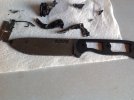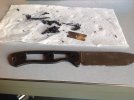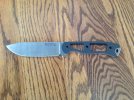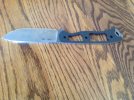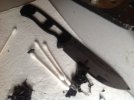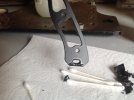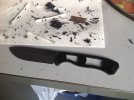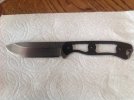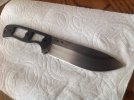- Joined
- Feb 7, 2018
- Messages
- 4
Hey all, first time Becker owner looking to strip the coating from my BK-7. I've done some research and mainly found seemingly irresponsible and questionable techniques from the most popular YouTube walkthroughs. Hoping some experienced folk here can make sure I'm doing this right.
After removing the scales I'll soak the full blade hanging upright by a small wire, within a stainless steel water bottle full of paint stripper. I figure keeping things upright and contained within the water bottle will provide a clean container for transporting the used paint stripper to a hazardous waste collection site ran by the city.
After 10-15 minutes I'll remove the blade from stripper, and use a nylon gun cleaning brush to scrape the coating off into a disposable pan, scrapings carefully transported to the container when complete. Soak/repeat until clean. I got PU coated nylon gloves for protection.
I picked up a 120-grit sanding sponge like this: https://www.amazon.com/gp/product/B00OB250I0/ref=oh_aui_detailpage_o01_s00?ie=UTF8&psc=1
I figured the grooves in the sanding sponge would help remove coating from tougher angles around the blade handle. Is that grit fine enough, once the process is complete and I've washed the blade, do I need to do some further buffing with a finer grit? Is there some kind of fancy oil treatment I really do need to give it at this point? Can I instead just walk out to the forest and start chopping some logs? I'd rather cover my blade in forest than mustard.
I've seen some choose to force a patina with mustard, etc. to protect the blade. Personally, I've just enjoyed watching my blades gain a natural patina from use in the mountains. I'm a fan of how Alfie's has turned out with similar treatment:
Are we really sacrificing that much life of the blade by allowing a natural patina instead of forcing a mustard patina, etc.? I don't really like how the forced patina/blueing looks. I'm happy to buy a few spare BK-7s if that's what it will take to get a lifetime use if I am opting for too much abuse.
I picked up stainless hardware and blue loctite for re-assembling with micarta scales when all is done. I'll post a pic once it's complete.
Final question, anyone know of a better sheath maker for these blades? I will probably end up just finding a local leather worker to make something custom if there isn't someone out on the internet specialized in making better sheaths for these BK-7s.
Thanks a lot for any insight.
After removing the scales I'll soak the full blade hanging upright by a small wire, within a stainless steel water bottle full of paint stripper. I figure keeping things upright and contained within the water bottle will provide a clean container for transporting the used paint stripper to a hazardous waste collection site ran by the city.
After 10-15 minutes I'll remove the blade from stripper, and use a nylon gun cleaning brush to scrape the coating off into a disposable pan, scrapings carefully transported to the container when complete. Soak/repeat until clean. I got PU coated nylon gloves for protection.
I picked up a 120-grit sanding sponge like this: https://www.amazon.com/gp/product/B00OB250I0/ref=oh_aui_detailpage_o01_s00?ie=UTF8&psc=1
I figured the grooves in the sanding sponge would help remove coating from tougher angles around the blade handle. Is that grit fine enough, once the process is complete and I've washed the blade, do I need to do some further buffing with a finer grit? Is there some kind of fancy oil treatment I really do need to give it at this point? Can I instead just walk out to the forest and start chopping some logs? I'd rather cover my blade in forest than mustard.
I've seen some choose to force a patina with mustard, etc. to protect the blade. Personally, I've just enjoyed watching my blades gain a natural patina from use in the mountains. I'm a fan of how Alfie's has turned out with similar treatment:
Are we really sacrificing that much life of the blade by allowing a natural patina instead of forcing a mustard patina, etc.? I don't really like how the forced patina/blueing looks. I'm happy to buy a few spare BK-7s if that's what it will take to get a lifetime use if I am opting for too much abuse.
I picked up stainless hardware and blue loctite for re-assembling with micarta scales when all is done. I'll post a pic once it's complete.
Final question, anyone know of a better sheath maker for these blades? I will probably end up just finding a local leather worker to make something custom if there isn't someone out on the internet specialized in making better sheaths for these BK-7s.
Thanks a lot for any insight.
Last edited:


